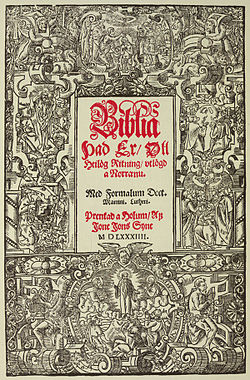Early Icelandic literature
The medieval Icelandic literature is usually divided into three parts:
The Eddas
There has been some discussion on the probable etymology of the term "Edda"[ citation needed ]. Most say it stems from the Old Norse term edda, which means great-grandmother, but some see a reference to Oddi, a place where Snorri Sturluson (the writer of the Prose Edda ) was brought up.

The Elder Edda or Poetic Edda (originally attributed to Sæmundr fróði, although this is now rejected by modern scholars) is a collection of Old Norse poems and stories originated in the late 10th century.
Although these poems and stories probably come from the Scandinavian mainland, they were first written down in the 13th century in Iceland. The first and original manuscript of the Poetic Edda is the Codex Regius , found in southern Iceland in 1643 by Brynjólfur Sveinsson, Bishop of Skálholt.
The Younger Edda or Prose Edda was written by Snorri Sturluson, and it is the main source of modern understanding of Norse mythology and also of some features of medieval Icelandic poetics, as it contains many mythological stories and also several kennings. In fact, its main purpose was to use it as a manual of poetics for the Icelandic skalds.
Skaldic poetry
Skaldic poetry mainly differs from Eddaic poetry by the fact that skaldic poetry was composed by well-known skalds, the Norwegian and Icelandic poets. Instead of talking about mythological events or telling mythological stories, skaldic poetry was usually sung to honour nobles and kings, commemorate or satirise important or any current events (e.g. a battle won by their lord, a political event in town etc.). In narratives, poems were usually used to pause the story and more closely examine an experience occurring. Poetry was also used to dramatise the emotions in a saga. For example, Egil's Saga contains a poem about the loss of Egil's sons that is lyrical and very emotional.
Skaldic poets were highly regarded members of Icelandic society, and are typically divided into four categories:
- Professional Poets (for the court or aristocrats) When Skaldic poets composed lyrics for the king, they wrote with the purpose of praising the king, recording his dealings, and celebrating him. These poems are generally considered historically correct [1] [ citation needed ] because a poet would not have written something false about the king; a king would have taken that as the poet mocking him.[ citation needed ] Ruling aristocratic families also appreciated poetry, and poets composed verses for important events in their lives as well.
- Private Poets. These poets did not write for financial gain, rather, they wrote to participate in societal poetic exchanges.
- Clerics. These poets composed religious verses.
- Anonymous Poets. These poets are anonymously quoted and incorporated into sagas. The anonymity allowed them to mask the comments they made with their verses. [2] [ citation needed ]
Skaldic poetry is written using a strict metric system together with many figures of speech, like the complicated kennings, favoured amongst the skalds, and also with a lot of “artistic license” concerning word order and syntax, with sentences usually inverted.
Sagas
The sagas are prose stories written in Old Norse that talk about historical aspects of the Germanic and Scandinavian world; for instance, the migration of people to Iceland, voyages of Vikings to unexplored lands, or the early history of the inhabitants of Gotland. Whereas the Eddas contain mainly mythological stories, sagas are usually realistic and deal with actual events, although there are some legendary sagas of saints, bishops, and translated romances. Sometimes mythological references are added, or a story is rendered more romantic and fantastical than as actually occurred. Sagas are the main sources for studying the history of Scandinavia between the 9th and 13th centuries.

Literature by women
Little medieval Icelandic writing is securely attested to be by women. In theory, anonymous sagas might have been written by women, but there is no evidence to support this, and known saga-writers are male. [3] A fairly large number of Skaldic verse stanzas are attributed to Icelandic and Norwegian women, including Hildr Hrólfsdóttir, Jórunn skáldmær, Gunnhildr konungamóðir, Bróka-Auðr, and Þórhildr skáldkona. However, the poetry attributed to women—just like much of the poetry attributed to men— is likely to have been composed by later (male) saga-writers. Even so, this material suggests that women may sometimes have composed verse. [4]
However, the authorial voice of the fifteenth-century rímur -cycle Landrés rímur describes itself with grammatically feminine adjectives, and accordingly the poem has been suggested to be the earliest Icelandic poem reliably attributable to a woman. [5]
